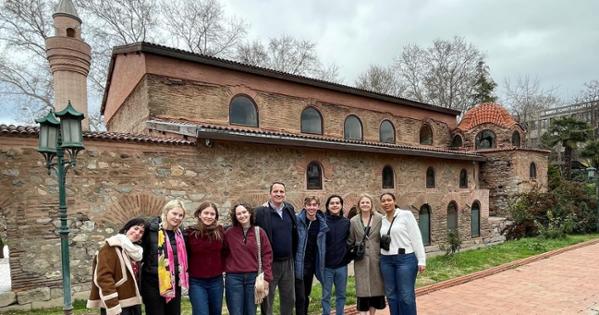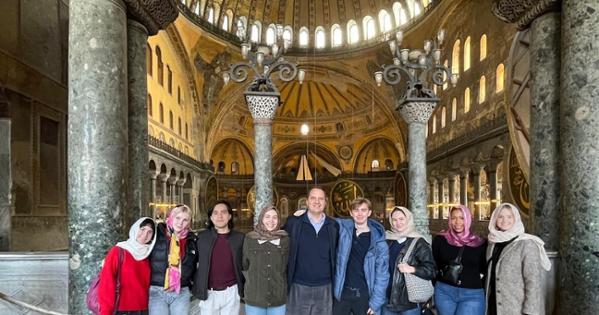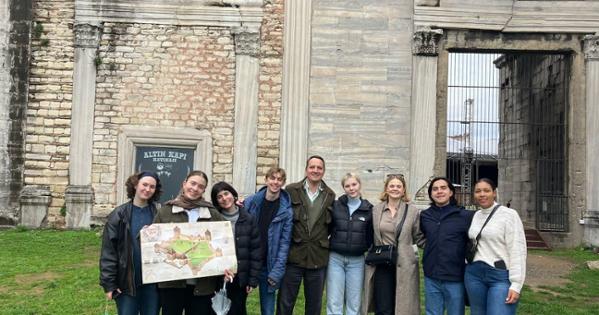Exploring Istanbul's links to Orthodoxy and History

In December of 2024, the Carmel Institute sponsored a class-trip to Istanbul, Türkiye. The entire group consisted of American University of students who spent part of their winter break exploring the legacy of the Eastern Roman Empire and Byzantine Orthodoxy.
Before departing from the US, the students read Bettany Hughes' Istanbul: A Tale of Three Cities as a general introduction to the history of the Eastern Roman Empire and its capital, Constantinople. The course combined discussions of the book with visits to churches, museums, mosques, and archaeological sites in Istanbul and beyond. In the process, students explored the history of the Byzantine Empire, the evolution of Eastern Orthodoxy, and interconfessional relations throughout the late classical, medieval, and modern era. Dr. Onur İşçi of Kadir Has University in Istanbul also joined the group on select museum visits, guided some of the tours, participated in discussions, and gladly answered many questions while touring Istanbul.
Carmel Institute director and associate professor of history Anton Fedyashin guided the students through museums and urban explorations, and led daily discussions based on the readings. In the process, the students learned to contextualize written texts through museum exhibitions, artistic representations, religious symbolism, and archaeological interpretations. The urban tours related architectural styles to religious, philosophical, and artistic trends. The class explored the impact of deep cultural structures on spiritual and visual expressions of medieval and early modern societies. The students also discussed the patterns, similarities, and differences between Byzantine Christianity and Russian Orthodoxy, Catholicism, Protestantism, and Islam.
Upon arrival, the students walked along Istiklal Street and then went up to the top of the 14th-century Galata Tower to take in the magnificent views of the seven hills of Constantinople.
On the first full day of the trip, Dr. Fedyashin gave the students a tour of the Istanbul Archaeological Museum as an introduction to eastern Mediterranean geopolitics and the history of Achaean civilization and the classical city-states of Greece. One of these, Megara, established the colony of Byzantion and influenced its evolution towards Constantinople. Exploring the artistic styles that dominated the Eastern Mediterranean region from the Archaic to the early Byzantine periods, the group discussed the literary, philosophical, and geopolitical trends leading up to the split between the Western and Eastern Roman Empires. The students also reflected on the intellectual and spiritual legacy of the classical era that the Christian world would inherit, coopt and, in some cases, suppress. After lunch, Dr. Fedyashin took the students on a tour of the Hagia Eirene Cathedral. Its inclusion within the boundaries of the Topkapi Palace complex saved the church, which was never turned into a mosque. It was the site of the Second Ecumenical Council of Constantinople in 381, which confirmed the Nicene Creed. The group then proceeded to explore the remnants of the ancient Hippodrome with its three remaining historic columns. After ushering the group through the unique private hippodrome museum in a Byzantine cistern, Dr. Fedyashin then led the students down to the Sea of Marmara to explore the ancient sea walls, Boukoleon Palace, and the remnants of the imperial Byzantine Palace. Touring the museums and the city, the group pounded out 29,000 steps on the first day.
 The group started the second day with a tour of the official residence of the Ottoman sultans, the Topkapi Palace Museum complex. They then moved on to the medieval world’s largest Orthodox cathedral, the Hagia Sophia. Turned back into a functioning mosque recently, it remains open to tourists between prayer times. However, only the second-floor galleries are accessible. They contain some of the most impressive Byzantine mosaics in Istanbul and even some unique Varangian graffiti. Even though it is 1,500 years old, Hagia Sophia’s sheer size and beauty continue to stun. No wonder that the Rus envoys who entered it famously remarked that they “knew not whether they were in heaven or on earth.” The group then went through the brand new audio-visual Hagia Sophia Museum across Sultanahmet Square from the cathedral. Opened in August of 2024, the museum ushers visitors through multiple rooms depicting the history of the cathedral with rich visual and audio arrangements. The group then visited a marvel of early Byzantine engineering, the 6th-century Basilica Cistern, and discussed the important contribution of Roman engineering to the development of Mediterranean and Eurasian civilizations. The students then walked up the ancient Mese Road to the Column of Constantine and then visited the Grand Bazaar. The discussions that day focused on the role of the Trojan War in Roman, Byzantine, and Christian Orthodox identity. Once it conquered the Macedonian and Greek territories and turned them into provinces, the Roman Republic began to emphasize Aeneas’s role as the city’s founder. Eastern Roman Emperor Constantine the Great emphasized the same connection with his new capital Constantinople by allegedly encasing the Palladium statue that Aeneas carried with him from Troy inside the base of the famous Constantine Column, which still stands close to Istanbul’s Grand Bazaar. In addition to the Trojan connection, this was also a day that focused on the impact of Emperor Justinian and his consort Empress Theodora.
The group started the second day with a tour of the official residence of the Ottoman sultans, the Topkapi Palace Museum complex. They then moved on to the medieval world’s largest Orthodox cathedral, the Hagia Sophia. Turned back into a functioning mosque recently, it remains open to tourists between prayer times. However, only the second-floor galleries are accessible. They contain some of the most impressive Byzantine mosaics in Istanbul and even some unique Varangian graffiti. Even though it is 1,500 years old, Hagia Sophia’s sheer size and beauty continue to stun. No wonder that the Rus envoys who entered it famously remarked that they “knew not whether they were in heaven or on earth.” The group then went through the brand new audio-visual Hagia Sophia Museum across Sultanahmet Square from the cathedral. Opened in August of 2024, the museum ushers visitors through multiple rooms depicting the history of the cathedral with rich visual and audio arrangements. The group then visited a marvel of early Byzantine engineering, the 6th-century Basilica Cistern, and discussed the important contribution of Roman engineering to the development of Mediterranean and Eurasian civilizations. The students then walked up the ancient Mese Road to the Column of Constantine and then visited the Grand Bazaar. The discussions that day focused on the role of the Trojan War in Roman, Byzantine, and Christian Orthodox identity. Once it conquered the Macedonian and Greek territories and turned them into provinces, the Roman Republic began to emphasize Aeneas’s role as the city’s founder. Eastern Roman Emperor Constantine the Great emphasized the same connection with his new capital Constantinople by allegedly encasing the Palladium statue that Aeneas carried with him from Troy inside the base of the famous Constantine Column, which still stands close to Istanbul’s Grand Bazaar. In addition to the Trojan connection, this was also a day that focused on the impact of Emperor Justinian and his consort Empress Theodora.
The third day began with a tour the Sultan Ahmed Mosque, often called the Blue Mosque for the stunning white-and-blue tiles that adorn its interior. The students also listened to the famous dueling call to prayer between the muezzin of Ayasofia and the Sultan Ahmed Mosque.
 They then took the subway to Yedikule Fortress, which constituted the southern end of the Theodosian Wall of Constantinople. Overlooking the Sea of Marmara, the fortress contained the famous Golden Gate of Constantinople, which is bricked up today. Yedikule offers great panoramas of the surrounding countryside, the sea, and the Mese road, which led from the Egnatian Way to the royal palace. Dr. Fedyashin showed the students the three levels of the Theodosian Wall and explained to them that the land section withstood every invasion until Mehmet the Conqueror took the city in 1453. It therefore remains human history’s largest and most successful urban defense wall, which fulfilled its function successfully for 1,000 years. The then took the city ferry to Istanbul’s Kadiköy District to explore the history and architecture of the Asian side with its Orthodox churches, synagogues, and mosques with Drs. Fedyashin and İşçi as guides.
They then took the subway to Yedikule Fortress, which constituted the southern end of the Theodosian Wall of Constantinople. Overlooking the Sea of Marmara, the fortress contained the famous Golden Gate of Constantinople, which is bricked up today. Yedikule offers great panoramas of the surrounding countryside, the sea, and the Mese road, which led from the Egnatian Way to the royal palace. Dr. Fedyashin showed the students the three levels of the Theodosian Wall and explained to them that the land section withstood every invasion until Mehmet the Conqueror took the city in 1453. It therefore remains human history’s largest and most successful urban defense wall, which fulfilled its function successfully for 1,000 years. The then took the city ferry to Istanbul’s Kadiköy District to explore the history and architecture of the Asian side with its Orthodox churches, synagogues, and mosques with Drs. Fedyashin and İşçi as guides.
The students spent the fourth day in the small town of Iznik about two hours’ drive southeast of Istanbul. Situated on Lake Iznik, the town became the capital of the Byzantine Empire after the Venetians sacked and occupied Constantinople in 1204. For the next 57 years, the ruling Byzantine dynasty operated out of ancient Nicaea (Iznik). But even before that, Nicaea hosted the first Ecumenical Church Council in 325. Upon arrival, Dr. Fedyashin toof the students through the Iznik Archaeological Museum and told them about the evolution and importance of the Nicene Creed, the Christian profession of faith, and how the church became increasingly restrictive towards the semantic openness and nuances of the ancient Greek language in articulating the basic principles of Christianity. The group then proceeded to the 2nd-century Roman theater of Iznik to talk about the evolution of entertainment and public performance from the pagan to the Christian era. They then had lunch on the shore of Lake Iznik in front of where the old Church of St. Neophyte stood where the first Council of Nicaea took place under Emperor Constantine the First. Only the foundations of the building remain and they are under water. After lunch, Dr. Fedyashin ushered the group through the Hagia Sophia Church, where the Seventh and final Ecumenical Council took place in 787. The group then went shopping for the famous Iznik tiles. The group thus visited the sites of six ecumenical councils on this trip: Nicaea (Iznik), Constantinople (Istanbul), and Chalcedon (Kadikoy). Only one site remained unexplored—Ephesus.
The fifth day began with a tour of the Tekfur Museum, which was part of the Blachernae Palace that stood on the Golden Hord end of the Theodosian Wall, which marked Constantinople’s last line of defense in 1453, when the Ottoman army attacked the Byzantine capital. Dr. Fedyashin gave the students a tour of the site where the last Byzantine Emperor Constantine XI took leave of his family and imperial court to join the capital’s defensive forces. Restored and reopened in 2017, the Tekfur Palace offers spectacular views from its rooftops to the extent of the city as it was in the fifteenth century. The group walked along the remaining section of the wall with a stop to see one of the best monuments of Byzantine architecture, the Chora Church. Recently reopened, the Chora Church is also the functioning Kariye Mosque. The Turkish government has made it accessible to the public, however. And people interested in 14th-century Byzantine frescoes and mosaics will find a rare treasure here. Preserved by the Ottomans because they plastered over the original decorations, the art in Chora is stunning. Off the beaten tourist track, it is a visual record of late Byzantine interpretations of three Christian stories. The frescoes depict Judgment Day. The two sets of extensive mosaics depict the lives of the Virgin Mary and Christ. After lunch, the group continued their three-hour walk back to the historic district. It passed under the Valentinian Aqueduct, a marvel of Byzantine engineering, and visited Shekhzade and Suleimaniye mosques designed by the renowned Ottoman architect Mimar Sinan. It finished the tour by visiting Sinan’s tomb.
Since the students’ flight did not leave until late afternoon of the sixth day, Dr. Fedyashin took the group on an extensive morning tour of Dolmabahçe Palace, the European-style residence of the last Ottoman sultans, and the site where Kemal Atatürk died in November of 1938. After that, the group made its way to the airport for their long journey back to Washington, DC.